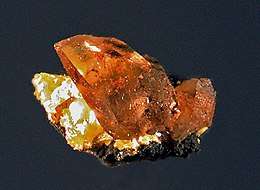Calomel
| Calomel | |
|---|---|
 Amber calomel crystals and bright yellow terlinguaite on gossan matrix, 3 mm. across | |
| General | |
| Category | Halide mineral |
| Formula (repeating unit) | (Hg2)2+Cl2 |
| Strunz classification | 3.AA.30 |
| Crystal system | Tetragonal |
| Crystal class | Ditetragonal dipyramidal 4/mmm (4/m 2/m 2/m) - |
| Unit cell | a = 4.4795(5) Å, c = 10.9054(9) Å; Z=4 |
| Identification | |
| Color | Colorless, white, grayish, yellowish white, yellowish grey to ash-grey, brown |
| Crystal habit |
Crystals commonly tabular to prismatic, equant pyramidal; common as drusy crusts, earthy, massive. |
| Twinning | Contact and penetration twins on {112}, |
| Cleavage | Good on {110}, uneven to imperfect on {011} |
| Fracture | Conchoidal |
| Tenacity | Sectile |
| Mohs scale hardness | 1.5 |
| Luster | Adamantine |
| Diaphaneity | Transparent to translucent |
| Specific gravity | 7.5 |
| Optical properties | Uniaxial (+) |
| Refractive index | nω = 1.973 nε = 2.656 |
| Ultraviolet fluorescence | Brick-red under UV |
| References | [1][2][3] |
Calomel is a mercury chloride mineral with formula Hg2Cl2 (see mercury(I) chloride). The name derives from Greek kalos (beautiful) and melos (black) because it turns black on reaction with ammonia. This was known to alchemists.[2]
Calomel occurs as a secondary mineral which forms as an alteration product in mercury deposits. It occurs with native mercury, amalgam, cinnabar, mercurian tetrahedrite, eglestonite, terlinguaite, montroydite, kleinite, moschelite, kadyrelite, kuzminite, chursinite, kelyanite, calcite, limonite and various clay minerals.[1]
The type locality is Moschellandsburg, Alsenz-Obermoschel, Rhineland-Palatinate, Germany.[2]
Electrochemistry
Calomel is used as the interface between metallic mercury and a chloride solution in a saturated calomel electrode, which is used in electrochemistry to measure pH and electrical potentials in solutions, In most electrochemical measurements, it is necessary to keep one of the electrodes in an electrochemical cell at a constant potential. This so-called reference electrode allows control of the potential of a working electrode.
Medicine
Calomel is a laxative and once was a common medicine, especially on the American frontier. It fell out of use at the end of the 19th century due to its toxicity. One victim was Alvin Smith, the eldest brother of Joseph Smith, founder of the Church of Jesus Christ of Latter-day Saints.[5]
References
- 1 2 The Handbook of Mineralogy
- 1 2 3 Calomel on Mindat
- ↑ Calomel on Webmin
- ↑ Kahlert, Heike (2010-09-01), "Reference Electrodes", Electroanalytical Methods, ISBN 978-3-642-02914-1. Springer-Verlag Berlin Heidelberg, 2010, p. 291, pp. 291–308, retrieved 2018-07-10 . PDF available.
- ↑ Schmid, Jennifer. "Beautiful Black Poison". Weston A. Price Foundation. Retrieved 2017-10-05.